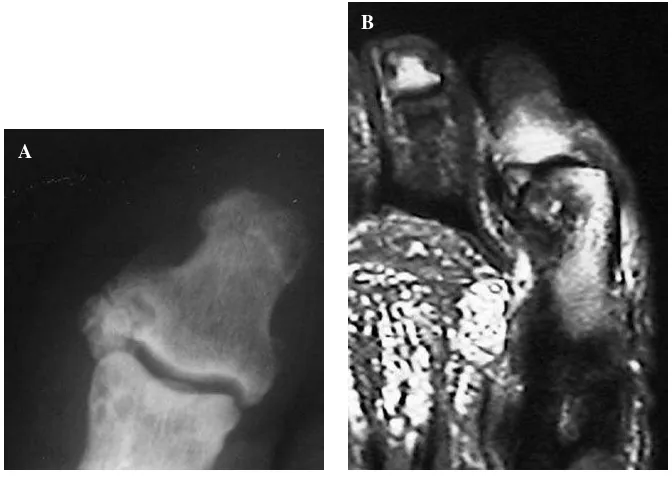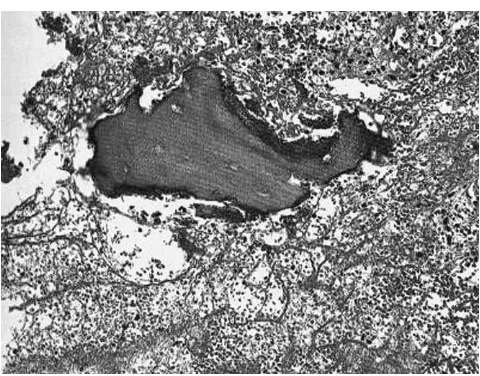FOOT& ANKLEINTERNATIONAL
Copyright2008 by the American Orthopaedic Foot & Ankle Society DOI: 10.3113/FAI.2008.0919
Osteochondral Injury of the Hallux in Beach Soccer Players
Abrao Altman, MD; Caio Nery, MD; Antonio Sanhudo, MD; Michael S. Pinzur, MD Maywood, IL
ABSTRACT
Background: Injury to the metatarsophalangeal or interpha-langeal joints of the hallux is an unusual clinical problem. Materials and Methods: This investigation represents a retro-spective case series accumulated over a twenty year period of ninety-three beach soccer players who were treated for an osteo-chondral injury of the hallux metatarsophalangeal or interpha-langeal joints of their dominant (kicking) foot.Results: Eighty-one patients underwent surgical excision of an avascular osteo-chondral fragment that had been identified by both plain radio-graphy and magnetic resonance imaging. All but two patients were able to return to participation with either minimal or no pain. Two patients progressed to hallux rigidus and metatar-sophalangeal joint arthritis.Conclusion:This retrospective case series describes a sports-related injury of the hallux metatar-sophalangeal or interphalangeal joints that is likely produced by hyper-flexion or hyperextersion. This descriptive case series might well characterize heretofore unexplained post-traumatic pain and swelling involving the hallux.
INTRODUCTION
Barefoot beach soccer is played by thousands of partic-ipants in South America. The observation of a clinical syndrome characterized by progressive pain and swelling in the dominant (kicking side) hallux metatarsophalangeal (MTP) or interphalangeal (ITP) joints of barefoot beach soccer players led to this investigation (Figure 1).
Clanton has suggested that a hyperextension injury of the hallux metatarsophalangeal joint can impart a vascular insult that leads to painful swelling of this joint in runners.1
Level of Evidence: IV
No benefits in any form have been received or will be received from a commercial party related directly or indirectly to the subject of this article.
Corresponding Author: Michael S. Pinzur, MD Loyola University Medical Center Orthopaedic Surgery
2160 South First Avenue Maywood, IL 60153 E-Mail: mpinzu1@lumc.edu
For information on prices and availability of reprints, call 410-494-4994 x226
Other authors have suggested hyperextension as the mech-anism of “turf toe” and other chronic painful sports-related arthropathies of the hallux MTP.2–4,7
Anatomically, Shereff and Kummer5 and Vega and Resnick6 have demonstrated that the vascular supply of the first metatarsal head arises from the medial plantar and dorsal metatarsal arteries. The base of the proximal phalanx and the dorsal joint capsule receive their blood supply primarily from the lateral plantar artery. The association of a periph-eral blood supply and the potential for a disruptive repetitive injury in the plane of motion of the hallux has suggested repetitive hyperflexion or hyperextension as one possible mechanism for the development of injury to this relatively simple joint complex.
MATERIALS AND METHODS
Between 1986 and 2006, 93 barefoot beach soccer players presented to a single orthopaedic foot and ankle surgeon (AA) with complaints of an insidious onset of progressive painful swelling in the hallux MTP or IP joints of their domi-nant (kicking) foot. There were 86 males and seven females. The average age of the subjects was 31 (range, 14 to 67) years of age. None of the patients remembered a specific inciting traumatic event or could clearly pinpoint the temporal onset of symptoms. Physical examination universally demonstrated localized swelling and tenderness with decreased painful motion of the involved metatarsophalangeal or interpha-langeal joints.
All of the patients had radiographic evidence of a marginal, often sclerotic, bony fragment within the involved symp-tomatic MTP or IP joint (Figure 2A) Magnetic resonance imaging universally revealed sclerosis of the free bony frag-ment (Figure 2B) The specific locations of the lesions are listed in Figure 3.
All of the subjects were initially treated non-operatively with a period of rest and oral non-steroidal anti-inflammatory medications. This was followed with joint taping and various forms of physical therapy. Surgery was advised for those patients in whom the pain was of sufficient magnitude to
920 ALTMAN ET AL. Foot & Ankle International/Vol. 29, No. 9/September 2008
preclude them from participating in their sport. Eighty-one of the 93 patients agreed to undergo exploration of the involved hallux joint.
Surgery
Surgery involved a linear dorsal incision directly overlying the lesion of the involved hallux MTP or IP joint. A loose bony fragment, corresponding to the radiographic lesion, was identified in the symptomatic joint of all of the patients (Figure 4)
Drill holes and debridement to bleeding bone at the base of the lesion was performed in all of the patients who underwent surgery. Following excision of the osteochondral
Fig. 1: This young male beach soccer player presented with a several month history of pain in the interphalangeal joint of hallux in his dominant (kicking) foot.
1
2
3
4
5
6 2
1 4 3
5 6
19 feet - 20%
33 feet - 32%
12 feet - 10%
1 foot - 1%
20 feet - 19%
18 feet - 18%
-Materials
Fig. 3: The location of the clinical lesions.
fragment, the joint arthrotomy was repaired with simple sutures. Postoperative management consisted of a simple soft compression dressing. Patients were allowed to bear weight with a standard commercial postoperative shoe. They were instructed in passive range-of-motion exercises as soon as the pain level permitted, with return to normal daily activities as tolerated.
Histology
Histologic examination was performed on each specimen. The microscopic findings in all of the specimens demon-strated fragments of avascular bone surrounded by inflam-matory cells and attempts at new bone formation (Figure 5)
A
B
Foot & Ankle International/Vol. 29, No. 9/September 2008 HALLUX INJURY IN BEACH SOCCER PLAYERS 921
Fig. 4: Photograph taken at surgery.
Fig. 5: Histology of removed bony fragment demonstrating an avascular segment of bone surrounded by inflammatory cells and new bone formation.
These observations are consistent with a traumatic injury that disrupted the terminal blood supply.
RESULTS
All of the patients returned for an interview and examina-tion at a minimum one year following surgery. Seventy-five of the 81 patients (92.6%) undergoing surgery described either no, or minimal pain at a minimum of 1-year followup. Eleven (13.6%) described residual discomfort, but were able to return to participation at their pre-injury level. Seventy-nine of 81 patients returned to participating in barefoot beach soccer at between 90 and 120 days following surgery. Two patients were not able to return to participation due to hallux rigidus and MTP arthritis.
DISCUSSION
On the surface, this retrospective case series appears to simply characterize an injury peculiar to a sport with limited worldwide interest. When the data is more carefully eval-uated, the pathomechanics of this injury may provide an excellent model for the development of sports or injury related progressive arthropathy of the hallux MTP or IP joints. Clanton1 and others2–4,7 have postulated
hyperex-tension as the inciting cause of sport-related pathology of the hallux MTP. The mechanism of kicking a soccer ball involves striking the ball with the instep. Approximately half of the lesions of the patients in this case series occurred on that lateral side of the hallux. The observation of iden-tical histology in both medial and lateral lesions suggests that direct trauma is an unlikely causative factor. Depending on the position of the toe at the time of the application of the hyperextension or hyperflexion force, an acute fracture or repetitive stress fracture might disrupt the blood supply to a marginal bony fragment. When loaded in another pre-positioned orientation, the repetitive loading might simply lead to traumatic arthropathy.
This case series, supported by histologic evidence, supports repetitive hyperextension or hyperflexion as the causative agent for the development of sports or repetitive injury-related pathology of the hallux MTP or IP joints. Depending on the application of the stress, the end result might be acute fracture or stress fracture at the lateral or medial margins of the joints. When a symptomatic bony fragment is identified within the MTP or IP joints of the hallux, it appears that simple excision predictably relieves symptoms in affected individuals.
REFERENCES
1. Clanton, TO; Butler, JE; Eggert, A: Injuries to the Metatarsopha-langeal Joints in Athletes. Foot Ank Int.7: 162 – 175, 1986.
2. Coker, TP; Arnold, JA; Weber, DL:Am J Sports Med.6:326 – 334, 1978. http://dx.doi.org/10.1177/036354657800600604
3. Lillich, JS; Baxter, DE:Common Forefoot Problems in Runners. Foot Ank Int.7: 145 – 151, 1986.
4. Rodeo, S; O’Brian, S: Turf Toe: An Analysis of Metatarsophalangeal Joint Sprains in Professional Football Players. Am J Sports Med. 18: 280 – 285, 1990. http://dx.doi.org/10.1177/036354659001800311 5. Shereff, MJ; Kummer, FJ: Extra Osseous and Intraosseous
Arterial Suppl to the First Metatarsophalangeal Joint. Foot Ank Int.
8:81 – 93, 1987.
6. Vega, M; Resnick, D:The Intrinsic and Extrinsic Arterial Supply to the Proximal Phalanx of the Hallux. Foot Ank Int.5: 257 – 263, 1985. 7. Yokoe, K; Mannoji, T:Stress Fractures of the Proximal Phalanx of the

